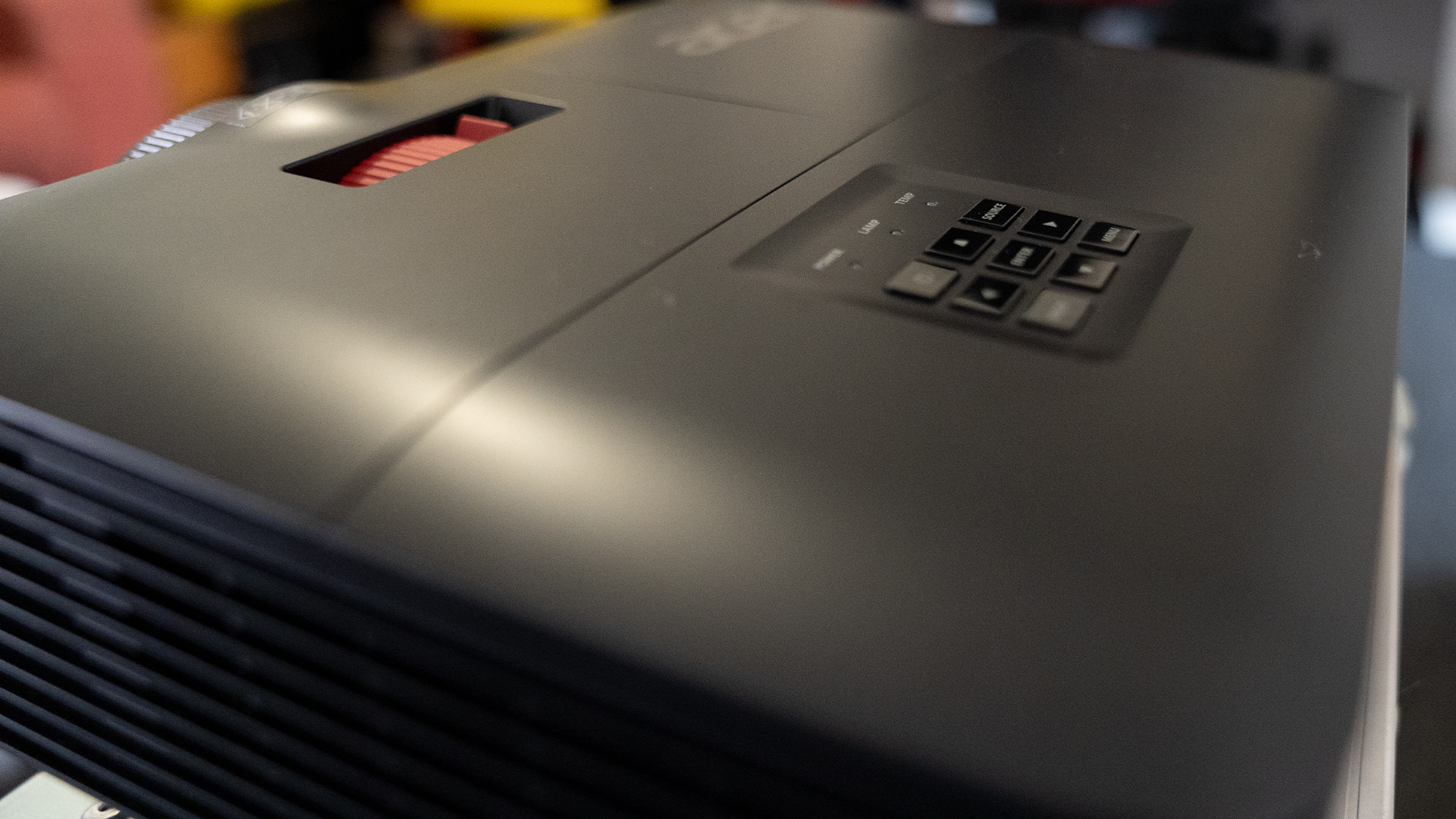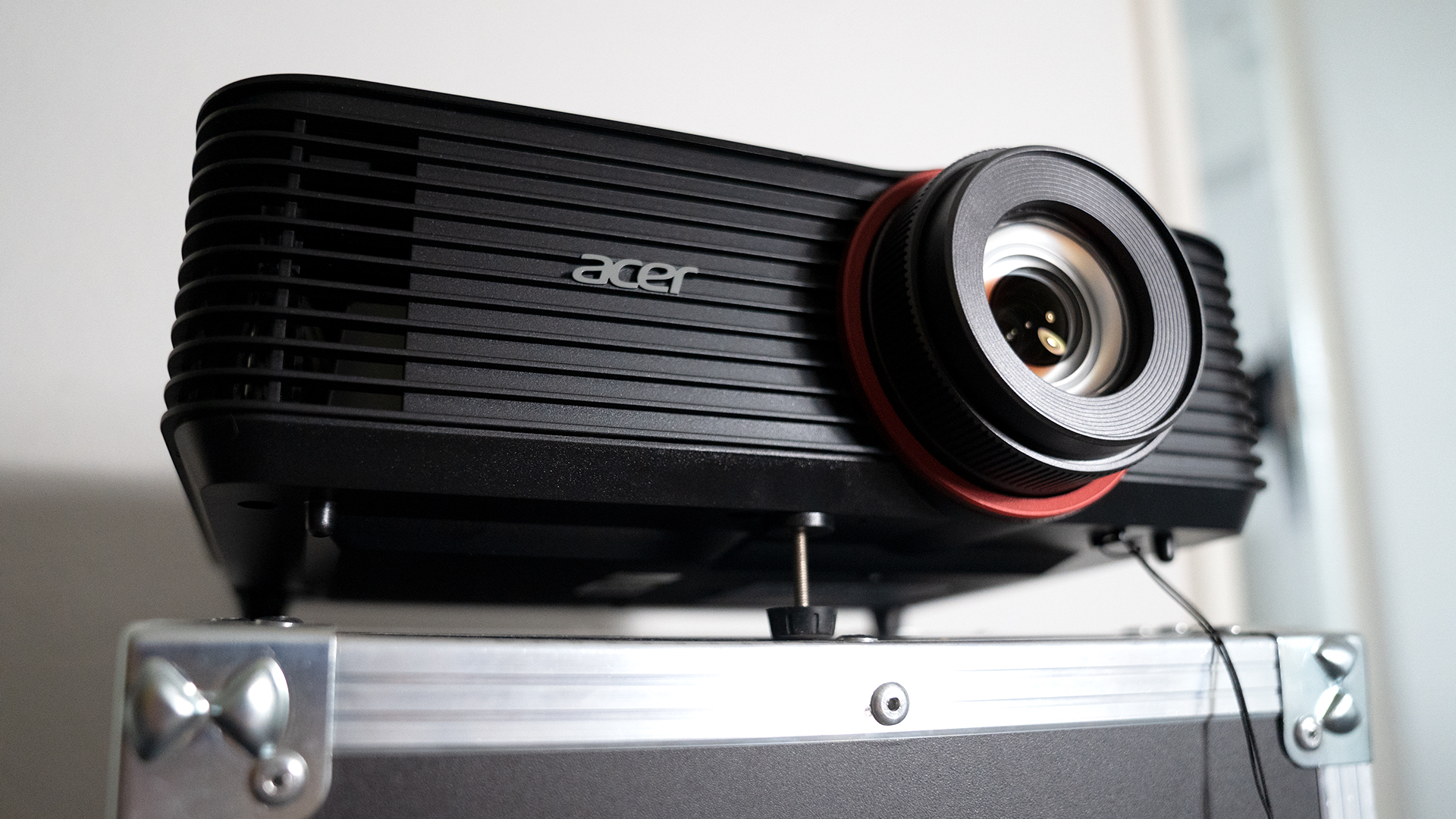Our Verdict
A one trick projector made for speed-running and competitive retro gamers. It's got a great refresh rate and low input lag, but very little in the way of future-proofing.
For
- Impressive 8.3ms input latency for a projector
- Smooth 120Hz performance
- Versatile 2x digital zoom fir long/med throw
- Good colour accuracy
Against
- Haven't seen it available in the US
- No smart features
- No DisplayPort or USB Type-C
- Speakers are weak and only produce limited range
- Super basic keystone correction
PC Gamer's got your back
The Acer G550 Nitro was designed for speed and smooth frames, and while it does manage to hit that particular mark with flying colours—1.07 billion of them to be exact—there's more to gaming on a projector than speed. Imagine going into a projector purchase expecting all the modern features they come with nowadays, only to end up with an abundance of essentially obsolete ports, a distinct lack of smart features, sub-par sound, and a frankly worrying lamp life rating.
Sadly, this is the story with the Acer G550 Nitro, which only manages to hit a few bars for gaming, and low ones at that. The main takeaway is not to be blinkered by the speedy specs, as there are plenty of non speed-related features users should demand from a gaming projector, nowadays.
Speaking of being blinkered, before we go any further I'll make one thing clear: while you may have spotted 4K in the G550 Nitro's description, this is not a 4K projector. It does support 4K input, but since you have the ability to switch down the output on most input devices to the projector's native 1080p, there's hardly ever going to be a situation where this is useful. There's no upscaling to an approximation of 4K like the BenQ TK700STi does either, just downscaling. Essentially, if you're doing this you're just drawing more processing power than necessary, for what you're getting out of it.
Display Technology: DLP
Resolution: 1080p HDR
Contrast ratio: 1,000:1 (dynamic)
Input Lag: 8.3ms
Throw ratio: 1.21 - 1.59:1
Brightness: 2,200 ANSI lumens
Lamp Life: 3,500 hours
Ports: 2 x VGA in │ 1 x VGA out │ 1 x composite video input - RCA │ 1 x HDMI │ 1 x Mobile High-Definition Link (MHL) / HDMI │ 3.5 mm audio 2 x in 1 x out │ 1 x DB-9 │ 1 x USB Type-A │ 1 x 3D sync
Size: 313 x 240 x 111mm
Price: £421
The G550 Nitro runs pretty warm. Thankfully it doesn't blast out hot air from the back end right into your eyes, and there's actually a warning light to let you know if the lamp temperature is getting too much—all through my hours of testing the light didn't blink once. Sadly, though, the lamp life still doesn't cut it.
When you do the calculations, its 3,500 hours is just shy of two years, provided you use it around 5 hours every night. That's nowhere near the 20,000-30,000 hours you can expect from some of the best gaming projectors we've tested. Acer claims 'extreme economic mode' can push the lamp life up to 12,000 hours, but you still only get a 1 year warranty on the lamp. I also haven't been able to find any replacement lamps in online stores.
Pitting the Acer G550 Nitro against the similarly specced £1,200 BenQ X1300I, sure, you can get it a heck of a lot cheaper nowadays (£420 at time of writing). And while the two are essentially a match with 120Hz refresh rate and 8ms response times, and both come touting HDMI 2.0, the Nitro fails to reach for other important quality-of-life features that the BenQ does.
As for software options, there's not much on the thing itself. To access gaming modes and the like, you need to download the Acer Display Widget to whatever device you're using it with, which is not great if you're on console. There's at least some rudimentary form of keystone correction, but it's so basic compared to many projectors today. Plenty of the competition will even work automatically.
Clever keystone correction and smart features are sort of essential today, and the lack of Android TV is fine if you've got your gaming PC hooked up to it all the time, but if you just want to watch the odd movie on Netflix without switching on your PC, this isn't the projector for you.


That's not least because the built-in speakers are weak enough that you can't hear a thing below 100Hz, or above 15kHz. The brightness and contrast are a little lacking, too. Images can look a little washed out in a room with a fair amount of ambient light; in the dark though, the Nitro does its job well. The colours are vibrant; playing Divinity: Original Sin 2 on it made that abundantly clear, and I was able to see for myself how impressive the low input lag was. Ghosting was pretty minimal, too.
Still, despite the Acer G550 Nitro touting a few impressive qualities that make it great for competitive gaming, there are so many things holding it back in today's market. Simply put, the G550 Nitro is kind of past its prime. It's covered in VGA ports, and even has an old DB-9 port on the back, too. Since these kinds of connections are now phasing into legend, there's a lot of mostly useless gumpf on the back where a preferable DisplayPort or USB Type-C would be sitting in a more modern piece of kit.
Sure, you can pick it up nowadays for a much lower price than its more recent counterparts, but it's not going to last much longer as an option in this era. If you've a one track mind for retro and competitive gaming, this is a nice budget option, but if you want to make the most of your money, spend a little more on something like the Xgimi Halo. The input lag is a little higher, and the refresh rate is capped at 60Hz, but for a couple of hundred quid more, you get something portable, smart and modern, with a much longer lamp life.
Honestly, if Acer thought it could distract me from the Nitro's downfalls by offering a little carry bag and a plastic shield for the lamp, it had another think coming.
A one trick projector made for speed-running and competitive retro gamers. It's got a great refresh rate and low input lag, but very little in the way of future-proofing.

Screw sports, Katie would rather watch Intel, AMD and Nvidia go at it. Having been obsessed with computers and graphics for three long decades, she took Game Art and Design up to Masters level at uni, and has been rambling about games, tech and science—rather sarcastically—for four years since. She can be found admiring technological advancements, scrambling for scintillating Raspberry Pi projects, preaching cybersecurity awareness, sighing over semiconductors, and gawping at the latest GPU upgrades. Right now she's waiting patiently for her chance to upload her consciousness into the cloud.


